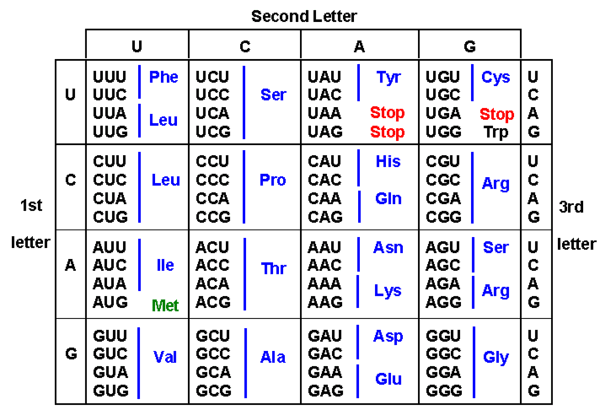Translation / Protein Synthesis
Key Questions
-
Answer:
Protein synthesis is the process where cells create proteins.
Explanation:
There are two steps in protein synthesis. They are transcription and translation.
During transcription, mRNA (Messenger RNA) is formed in the nucleus of the cell. After mRNA has been made, it leaves the nucleus and goes to the ribosomes in the cytoplasm, where translation occurs. (DNA never leaves the nucleus.)
During translation, mRNA attaches itself to the ribosome. Then, tRNA (Transfer RNA) reads the mRNA codons (a codon is a sequence of three nucleotides that code for a protein) and attaches amino acids accordingly. This continues until tRNA reaches a stop codon.
-
Answer:
Codons are three letter genetic words: and the language of genes use 4 letters (=nitrogenous bases). Hence 64 words are there in genetic dictionary, to represent 20 amino acids that the biological organisms use.
Explanation:
And you must note that more than one codon may code for the same amino acid. This is referred to as degeneracy of the code.
For example, three amino acids are coded by any of six different codons, and that alone uses up 18 of the 64 combinations.
Three of the codons are stop codons.
They do not code for any amino acid.
Instead, they act as signals to end the genetic message carried by messenger RNA .
The number of amino acids coded by codons is
#1 " codon" × color(white)(l)2 " amino acids" = color(white)(ll)2 " codons"#
#2 " codons" × 9 " amino acids" = 18 " codons"#
#3 " codons" × 1 " amino acid" = color(white)(X)3 " codons"#
#4 " codons" × 5 " amino acids" = 20 " codons"#
#6 " codons" × 3 " amino acids" = 18 " codons"#
#color(white)(XXXXXXXXXXXXXXXX)3" stop codons"#
#stackrel(—————————————————————————)(color(white)(XXXXXXXXXl)"TOTAL" = 64 " codons")# Here's a chart that gives the codon assignments for the amino acids.

-
Answer:
Translation occurs when ribosomes use information from RNA to build proteins.
Explanation:
Translation is the second phase of protein synthesis. It follows transcription, in which the information in DNA is "rewritten" into mRNA. During translation, the mRNA attaches to a ribosome. Transfer RNA (tRNA) molecules then "read" the mRNA code and translate the message into a sequence of amino acids. Every three nucleotides in the mRNA make up one codon, which corresponds to one amino acid in the resulting protein. The ribosome tracks along the mRNA until it reaches a stop codon, signaling the assembly of mRNA and ribosome to break apart.
Below is a stop-motion Vine video that summarizes the steps of translation.
The video below provides a summary of how the processes of transcription and translation occur using the Shockwave tutorial DNA Workshop from PBS.